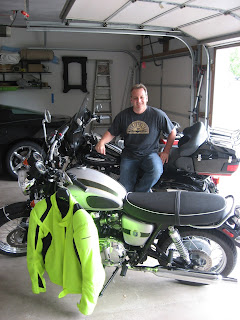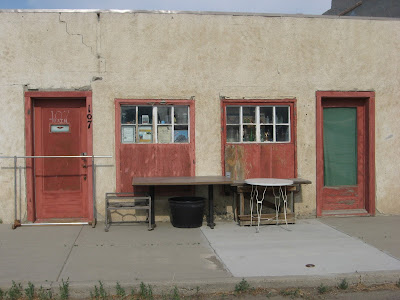 |
| Ron Soave and the glow-in-the-dark dream coat |
Those fluorescent
yellow jackets you see the very occasional motorcyclists wearing are designed
to save your life. Have to say, it saved my butt a couple of Sundays back when
I was leaving my last stop on US 20 before braving Chicago, Interstate 94 and
my return home to Chelsea, Michigan. And that’s where the Kingston Trio enter
the picture.
Those old
enough to remember the Kingston Trio may remember their hit song about “Charlie”
who did not have enough change to pay the exit fare from the subway. He
spent the rest of his life riding beneath the streets of Boston while his wife
threw him sandwiches from the platform. There are people in this same
predicament right now, wandering the Illinois Tollway where you often have to
pay to get off and the toll gate is unmanned and exact change only.
After a
pleasant night with friends Ron and Lynette and their two boys in Roscoe,
Illinois, Ron led me the circuitous route to the Tollway for my last leg home.
He had given me a handful of change and some singles for the “automatic tolls”
between there and Chicago. I used up all of the change at the entrance ramp and
then stopped at the first service plaza for gas. My low fuel light had been
glowing signaling about 25 miles or less left in the tank. At the
pump I realized I had neither my wallet nor my cell phone. No money, no charge
card, no communication…no recollection of which exit or which roads to take to
get back to Ron’s. I vaguely remembered setting the phone and wallet on the
back of the motorcycle while I pulled on my armored riding pants. They must be on the ground in front of his
garage door!
I used Ron’s handful of dollar bills, put
just under two gallons of gas in the bike, and headed off to find an exit for a
U-turn. Unfortunately, there was a toll plaza in the way. No money; no “I-Pass”
transponder; a distinct feeling of desperation deep in my gut; I realized I
would have to “run” the toll house and try to explain my predicament
to the state police later. Then I discovered I could not exit to make a U-turn without paying exact
change to get off the Tollway, and exact change again to get back on in the
other direction. It was me against the security camera.
Some of life’s
challenges demand a bold action. Not knowing which exit would lead me in the
direction of Roscoe, I began a lawless pattern of exiting and re-entering the
Tollway at every opportunity, trying to recognize the intersection where Ron
had bid me farewell. And it seemed every one of them required exact change to
get on or off. I was on my way to jail, I just knew it!
Eventually,
I found myself in Rockford, Illinois—sounds like Roscoe, must be close by. At a
convenience store I was lucky to discover Ron had a land-line phone which meant
there was an address in the phone book. Then a fellow with a smartphone mapped
it for me and I was able to write down the directions back to Ron and Lynette’s…and
my wallet, I hoped. Once I got there, I was dismayed to find no wallet, nor
cell phone, and no Ron or Lynette at home. I sat on the front porch. I felt
like curling into a small ball but was interrupted by Buddhist thoughts of life being a
never-ending series of imperfections in the wooden wheel of the cart. As long as the
wheel keeps turning, it keeps bumping. It is the only way life is. Dukkha. A neighbor had Ron’s cell number, we found him 20 minutes
away shopping, and he was on his way home to open the garage
door. I was now sure my wallet was on
the floor safely locked up. Again, I sat on the porch, this time
watching my breath and noticing that my anxiety was but a transient feeling. I
hoped.
More dukkha. The garage
turned out to be empty, save for several of Ron's toys. Soon Ron’s son and I are walking through the
weeds along the country roads leading away from the house, shuffling our feet,
hoping to step on a wallet or a cell phone. Fat chance! Meanwhile, Ron retraces
our route of three hours before in the unlikely probability that he will find
my wallet lying in the road waving at him.That didn't happen either, but what did is at least as remarkable.
Now, for the
life-saving qualities of glow-in-the-dark motorcycle jackets. Ron’s Facebook
posting provides the best summary:
 | ||
| Rockford Aviators vs. Traverse City Beach Bums |
So my buddy and Spridget racer John Deikis calls Friday
afternoon saying he'll be passing close by at the tail end of his 3 week cross
country trip on his trusty 22 year old BMW RT. Saturday comes, and we meet up
at my workplace to look at cool planes and cars. We have a nice time there, and
ride the back roads to my house. We take a quick trip to Roscoe's Auto Museum,
which also sports the largest collection of Kennedy memorabilia in the world.
It's on to a few IPAs, grilled bacon wrapped filets and fresh garden picked
veggies. It's then on to a Rockford Aviators baseball game, then back to the
house for some pumpkin vodka drinks and stories til 1 am. After breakfast this
morning, I lead John out to the highway on the Triumph and bid John farewell.
I'm wearing my Kevlar jacket in safety yellow. This later takes on great
importance.
3 hours later, I'm out with the lads and I get a call from
our neighbor. John is at my house, thinking his wallet and cell phone are in my garage. I rush home, and, in fact, NO they are not. Freak out time. Now, John's
phone does not even have texting ability, let alone "Find My iPhone".
He only found my house by getting on and off 90 (and not paying the tolls
because he had no wallet or iPass) and driving around Roscoe and finding
someone else with a phone to look me up. We surmise the stuff was on one of the
saddle bags and flew off. We retrace steps, my son, John helping on foot, me on
the bike tracing the route back to I-90. On the way back from an unsuccessful
ride out to the highway, I pass the boys and John has miraculously found his
phone. I go back to drop off the bike and join the walk.
There is a knock at my door, A lady has found John's wallet.
She saw us on the road that morning and noticed my bright yellow jacket. She
saw something fly off John's bike and her daughter retrieved it (the wallet).
They looked up John on the internet and left a message at his home, 400 miles
away. Amazingly, they were on the road again later that day and noticed the Triumph motorcycle with the
yellow jacketed rider. They followed me home, since they knew I was with John.
Absolute miracle.
As I re-read it, the things that had to happen to make
this work were astronomically unlikely. So, I've been told that safety gear on
bikes does not make you any more visible. I think it's safe to say that isn't
true. I'm sure John will tell this more colorfully (no pun intended), but this
was a day to remember, and finally some good karma after having returned
several lost wallets myself in the past.
Off to buy a lottery ticket....
Ron
Good karma is right! I had explored most of northeastern California, ridden at least three world-famous motorcycle roads through western mountain ranges, and visited more interesting brew pubs than I could keep track of. I was able to stop at a national MG meet and saw some old friends from my "Rallye to Reno" adventure of several years ago. I met some wonderful people who welcomed me into their homes for the night-- people like BMW-riders Michael and Jana in Bend, OR and Greg and Barb in Corvallis. I followed the Lincoln Highway west in the year of its 100 anniversary and the Oregon Trail back east. I took US 20, the old two-lane route across the Great Plains, from Wyoming to Chicago. I ran out of gas and was helped by a bartender in Nebraska. I lost my wallet and was tracked down several hours later by an observant stranger in Illinois who followed a flourescent yellow motorcycle jacket hoping it was the same guy she saw that morning.
And now, I'm waiting for that letter from the State of Illinois, complete with security-cam photos of an old BMW named "Frank the Flying Brick." We know who you are and we want our money. You know what? I think I'll pay it.
 | ||||||||||
| Original "Field of Dreams," Dyersville, Iowa |













































